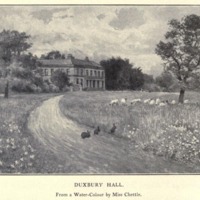Description
In contrast to Elizabeth Chettle’s romantic illustrations of the English countryside, Marcus Huish provides (in 1907) a less idealised description of industrial Lancaster with its ‘[w]orked-out collieries with tottering chimneys, and windowless buildings’. Druxbury Hall was built some years after Miles Standish left for America on the site of the Standish family home, and after falling into disrepair was demolised in 1956. As Huish states:
"To seek for English memorials of the Plymouth Captain we have to journey into the grimiest part of Lancashire, namely, the coal district of Wigan. In that town we come across the first notice of the name in a street called "Standish Gate," so termed because it was the entrance to the borough from the village of Standish, which lies some few miles away. Travellers northward bound, as they rush over the ground between Wigan and Preston in a London and North- Western express, may catch sight of the station bearing the title "Standish," but the outlook is hardly inviting at the present time. Worked-out collieries with tottering chimneys, and windowless buildings, are interspersed with newer factories called into being by recent trade improvement. A railway-side inn with the name of "The Dog and Partridge" seems strangely incongruous, although it points to a countryside amenable at no recent date to the gunner, who would hardly expect to look for sport now on a landscape ornamented only with blackened and decaying trees.
[…]
Duxbury Hall is not the house in which the Captain passed his childhood, as that was demolished, perhaps because it had fallen into a ruinous condition at the same time as the fortunes of the family. The present mansion was built in 1623, three years after the departure of the Mayflower expedition. It is now owned by Mr. Walter Mayhew, whose ancestors were not only emigrants to New England in the reign of Charles I., but were the grantors of lands there to one of Captain Standish's sons."

